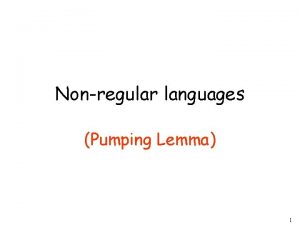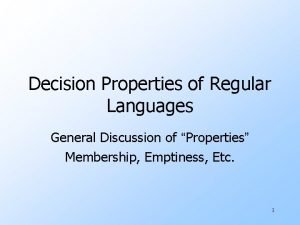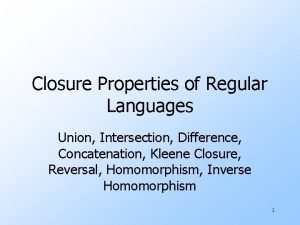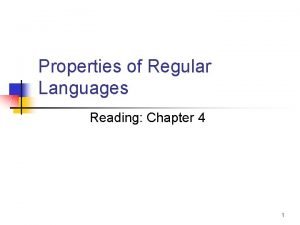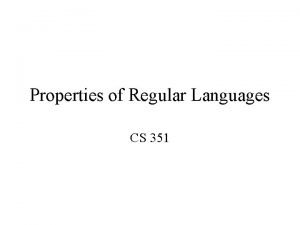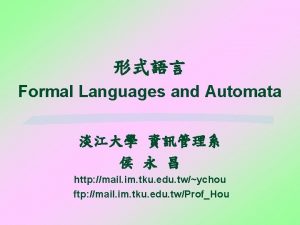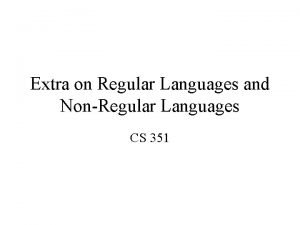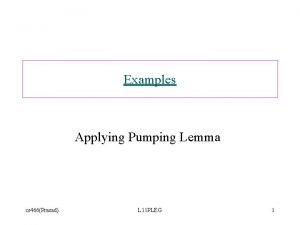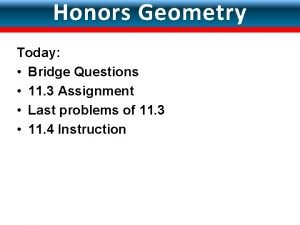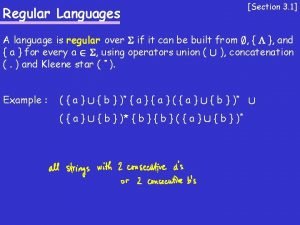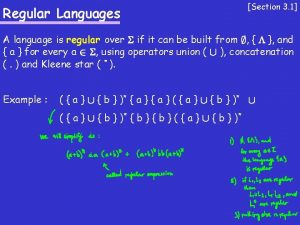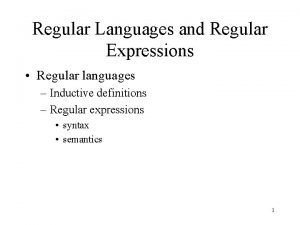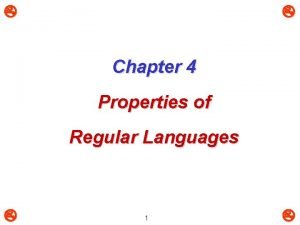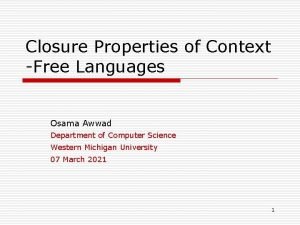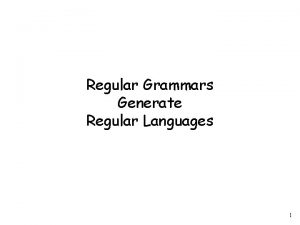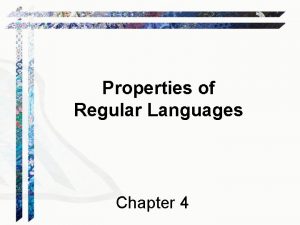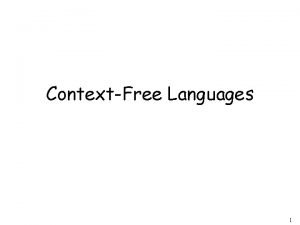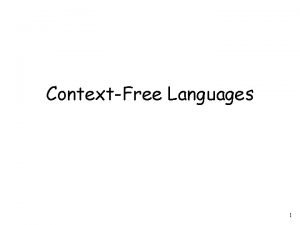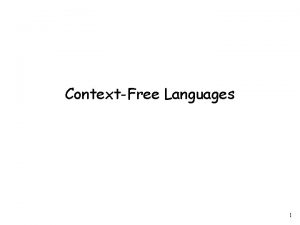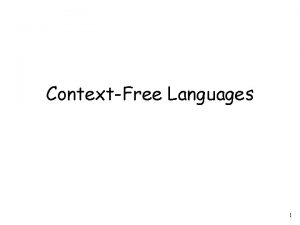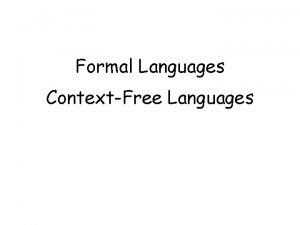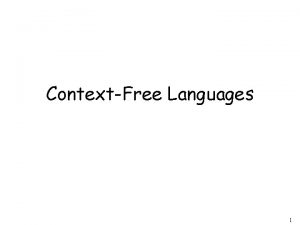Regular Languages Section 3 1 A language is
![Regular Languages [Section 3. 1] A language is regular over if it can be Regular Languages [Section 3. 1] A language is regular over if it can be](https://slidetodoc.com/presentation_image/889cc169b0fab50de4e39d1c8c9bf171/image-1.jpg)
![Regular Languages [Section 3. 1] A language is regular over if it can be Regular Languages [Section 3. 1] A language is regular over if it can be](https://slidetodoc.com/presentation_image/889cc169b0fab50de4e39d1c8c9bf171/image-2.jpg)
![Regular Languages [Section 3. 1] A language is regular over if it can be Regular Languages [Section 3. 1] A language is regular over if it can be](https://slidetodoc.com/presentation_image/889cc169b0fab50de4e39d1c8c9bf171/image-3.jpg)
![Regular Expressions [Section 3. 1] Recursive definition of regular expressions over : 1) ; Regular Expressions [Section 3. 1] Recursive definition of regular expressions over : 1) ;](https://slidetodoc.com/presentation_image/889cc169b0fab50de4e39d1c8c9bf171/image-4.jpg)
![Regular Expressions [Section 3. 1] Comments : - For convenience, we will also use Regular Expressions [Section 3. 1] Comments : - For convenience, we will also use](https://slidetodoc.com/presentation_image/889cc169b0fab50de4e39d1c8c9bf171/image-5.jpg)

![Regular Expressions [Section 3. 1] Give a regular expression for each of the following Regular Expressions [Section 3. 1] Give a regular expression for each of the following](https://slidetodoc.com/presentation_image/889cc169b0fab50de4e39d1c8c9bf171/image-7.jpg)
![Finite Automata [Sections 3. 2, 3. 3] Our simplest model of computation : - Finite Automata [Sections 3. 2, 3. 3] Our simplest model of computation : -](https://slidetodoc.com/presentation_image/889cc169b0fab50de4e39d1c8c9bf171/image-8.jpg)
![Finite Automata [Sections 3. 2, 3. 3] Example : the language of all strings Finite Automata [Sections 3. 2, 3. 3] Example : the language of all strings](https://slidetodoc.com/presentation_image/889cc169b0fab50de4e39d1c8c9bf171/image-9.jpg)
![Finite Automata [Sections 3. 2, 3. 3] More examples : - Language of strings Finite Automata [Sections 3. 2, 3. 3] More examples : - Language of strings](https://slidetodoc.com/presentation_image/889cc169b0fab50de4e39d1c8c9bf171/image-10.jpg)
![Finite Automata [Sections 3. 2, 3. 3] A (deterministic) finite automaton (FA, in some Finite Automata [Sections 3. 2, 3. 3] A (deterministic) finite automaton (FA, in some](https://slidetodoc.com/presentation_image/889cc169b0fab50de4e39d1c8c9bf171/image-11.jpg)
![Finite Automata [Sections 3. 2, 3. 3] Comment : We saw that we can Finite Automata [Sections 3. 2, 3. 3] Comment : We saw that we can](https://slidetodoc.com/presentation_image/889cc169b0fab50de4e39d1c8c9bf171/image-12.jpg)
![Finite Automata [Sections 3. 2, 3. 3] Defining the computation of an FA M=(Q, Finite Automata [Sections 3. 2, 3. 3] Defining the computation of an FA M=(Q,](https://slidetodoc.com/presentation_image/889cc169b0fab50de4e39d1c8c9bf171/image-13.jpg)
![Finite Automata [Section 3. 4] Kleene’s Thm: A language L over is regular iff Finite Automata [Section 3. 4] Kleene’s Thm: A language L over is regular iff](https://slidetodoc.com/presentation_image/889cc169b0fab50de4e39d1c8c9bf171/image-14.jpg)
![Operations on Finite Automata [Section 3. 5] Let M 1 = (Q 1, , Operations on Finite Automata [Section 3. 5] Let M 1 = (Q 1, ,](https://slidetodoc.com/presentation_image/889cc169b0fab50de4e39d1c8c9bf171/image-15.jpg)
![Operations on Finite Automata [Section 3. 5] Let M 1 = (Q 1, , Operations on Finite Automata [Section 3. 5] Let M 1 = (Q 1, ,](https://slidetodoc.com/presentation_image/889cc169b0fab50de4e39d1c8c9bf171/image-16.jpg)

![Operations on Finite Automata [Section 3. 5] Let M 1 = (Q 1, , Operations on Finite Automata [Section 3. 5] Let M 1 = (Q 1, ,](https://slidetodoc.com/presentation_image/889cc169b0fab50de4e39d1c8c9bf171/image-18.jpg)
![Closure Properties [Section 3. 5] We just saw that the class of regular languages Closure Properties [Section 3. 5] We just saw that the class of regular languages](https://slidetodoc.com/presentation_image/889cc169b0fab50de4e39d1c8c9bf171/image-19.jpg)
- Slides: 19
![Regular Languages Section 3 1 A language is regular over if it can be Regular Languages [Section 3. 1] A language is regular over if it can be](https://slidetodoc.com/presentation_image/889cc169b0fab50de4e39d1c8c9bf171/image-1.jpg)
Regular Languages [Section 3. 1] A language is regular over if it can be built from ; , { }, and { a } for every a 2 , using operators union ( [ ), concatenation (. ) and Kleene star ( * ). Example : ( { a } [ { b } )* { a } ( { a } [ { b } )* [ ( { a } [ { b } )* { b } ( { a } [ { b } )*
![Regular Languages Section 3 1 A language is regular over if it can be Regular Languages [Section 3. 1] A language is regular over if it can be](https://slidetodoc.com/presentation_image/889cc169b0fab50de4e39d1c8c9bf171/image-2.jpg)
Regular Languages [Section 3. 1] A language is regular over if it can be built from ; , { }, and { a } for every a 2 , using operators union ( [ ), concatenation (. ) and Kleene star ( * ). Example : ( { a } [ { b } )* { a } ( { a } [ { b } )* [ ( { a } [ { b } )* { b } ( { a } [ { b } )^* Simplify as :
![Regular Languages Section 3 1 A language is regular over if it can be Regular Languages [Section 3. 1] A language is regular over if it can be](https://slidetodoc.com/presentation_image/889cc169b0fab50de4e39d1c8c9bf171/image-3.jpg)
Regular Languages [Section 3. 1] A language is regular over if it can be built from ; , { }, and { a } for every a 2 , using operators union ( [ ), concatenation (. ) and Kleene star ( * ). Recursive definition of regular languages over :
![Regular Expressions Section 3 1 Recursive definition of regular expressions over 1 Regular Expressions [Section 3. 1] Recursive definition of regular expressions over : 1) ;](https://slidetodoc.com/presentation_image/889cc169b0fab50de4e39d1c8c9bf171/image-4.jpg)
Regular Expressions [Section 3. 1] Recursive definition of regular expressions over : 1) ; , { }, and { a } for every a 2 are regular languages represented by regular expressions __, __, respectively. 2) If L 1, L 2 are regular languages represented by regular Expressions r 1 and r 2, then L 1 [ L 2, L 1 L 2, and L 1* are regular languages represented by regular expressions _____, respectively. 3) No other expressions are regular expressions.
![Regular Expressions Section 3 1 Comments For convenience we will also use Regular Expressions [Section 3. 1] Comments : - For convenience, we will also use](https://slidetodoc.com/presentation_image/889cc169b0fab50de4e39d1c8c9bf171/image-5.jpg)
Regular Expressions [Section 3. 1] Comments : - For convenience, we will also use r+ and ri for i 2 N. - The priority of operators in decreasing order : Kleene’s star, concatenation, union. Parenthesize : a + b *c a + bc*

Regular Expressions Simplify the following regular expressions : - a*(a+ ) - a *a * - (a*b*)* - (a+b)*ab(a+b)* + a*b* [Section 3. 1]
![Regular Expressions Section 3 1 Give a regular expression for each of the following Regular Expressions [Section 3. 1] Give a regular expression for each of the following](https://slidetodoc.com/presentation_image/889cc169b0fab50de4e39d1c8c9bf171/image-7.jpg)
Regular Expressions [Section 3. 1] Give a regular expression for each of the following : - the language of all strings over {a, b} of even length, - the language of all strings over {a, b, c} in which all a’s precede all b’s, - the language of all strings over {a, b} with length greater than 3, - the language of all odd-length strings over {a, b} containing the string bb, - the language of all strings over {a, b} that do not contain the string aaa. Is the language { akbk | k 2 N } regular ?
![Finite Automata Sections 3 2 3 3 Our simplest model of computation Finite Automata [Sections 3. 2, 3. 3] Our simplest model of computation : -](https://slidetodoc.com/presentation_image/889cc169b0fab50de4e39d1c8c9bf171/image-8.jpg)
Finite Automata [Sections 3. 2, 3. 3] Our simplest model of computation : - has a tape with input, read once from left to right - has only a single memory register with the state
![Finite Automata Sections 3 2 3 3 Example the language of all strings Finite Automata [Sections 3. 2, 3. 3] Example : the language of all strings](https://slidetodoc.com/presentation_image/889cc169b0fab50de4e39d1c8c9bf171/image-9.jpg)
Finite Automata [Sections 3. 2, 3. 3] Example : the language of all strings over {a, b} with an even number of a’s.
![Finite Automata Sections 3 2 3 3 More examples Language of strings Finite Automata [Sections 3. 2, 3. 3] More examples : - Language of strings](https://slidetodoc.com/presentation_image/889cc169b0fab50de4e39d1c8c9bf171/image-10.jpg)
Finite Automata [Sections 3. 2, 3. 3] More examples : - Language of strings over {a, b} with at least 3 a’s. - Language of strings over {a, b} containing substring aaba. - Language of strings over {a, b} not containing substring aaba. - Language of strings over {a, b} with even number of a’s and odd number of b’s.
![Finite Automata Sections 3 2 3 3 A deterministic finite automaton FA in some Finite Automata [Sections 3. 2, 3. 3] A (deterministic) finite automaton (FA, in some](https://slidetodoc.com/presentation_image/889cc169b0fab50de4e39d1c8c9bf171/image-11.jpg)
Finite Automata [Sections 3. 2, 3. 3] A (deterministic) finite automaton (FA, in some books also abbreviated as DFA) is a 5 -tuple (Q, , q 0, A, ) where - Q is a finite set of states - is a finite alphabet (input symbols) - qo 2 Q is the initial state - A µ Q is a set of accepting states - : Q£ Q is the transition function
![Finite Automata Sections 3 2 3 3 Comment We saw that we can Finite Automata [Sections 3. 2, 3. 3] Comment : We saw that we can](https://slidetodoc.com/presentation_image/889cc169b0fab50de4e39d1c8c9bf171/image-12.jpg)
Finite Automata [Sections 3. 2, 3. 3] Comment : We saw that we can represent a finite automaton by a transition diagram. Draw the transition diagram for ( {qa, qb}, {a, b}, qa, {qb}, ) where is given by the following table (qa, a) qa (qa, b) qb (qb, a) qa (qb, b) qb Which strings does this FA accept ?
![Finite Automata Sections 3 2 3 3 Defining the computation of an FA MQ Finite Automata [Sections 3. 2, 3. 3] Defining the computation of an FA M=(Q,](https://slidetodoc.com/presentation_image/889cc169b0fab50de4e39d1c8c9bf171/image-13.jpg)
Finite Automata [Sections 3. 2, 3. 3] Defining the computation of an FA M=(Q, , q 0, A, ). Extended transition function * : Q£ * Q : 1) For every q 2 Q, let *(q, ) = 2) For every q 2 Q, y 2 *, and 2 , let *(q, y ) = We say that a string x 2 * is accepted by M if _____. A string which is not accepted by M is rejected by M. The language accepted by M, denoted by L(M) is the set of all strings accepted by M.
![Finite Automata Section 3 4 Kleenes Thm A language L over is regular iff Finite Automata [Section 3. 4] Kleene’s Thm: A language L over is regular iff](https://slidetodoc.com/presentation_image/889cc169b0fab50de4e39d1c8c9bf171/image-14.jpg)
Finite Automata [Section 3. 4] Kleene’s Thm: A language L over is regular iff there exists a finite automaton that accepts L. Recall L = { akbk | k ¸ 0 }. Is it regular ?
![Operations on Finite Automata Section 3 5 Let M 1 Q 1 Operations on Finite Automata [Section 3. 5] Let M 1 = (Q 1, ,](https://slidetodoc.com/presentation_image/889cc169b0fab50de4e39d1c8c9bf171/image-15.jpg)
Operations on Finite Automata [Section 3. 5] Let M 1 = (Q 1, , q 1, A 1, 1) and M 2 = (Q 2, , q 2, A 2, 2) be two FA’s. Union: We know that L(M 1) [ L(M 2) is regular. Construct an FA M such that L(M) = L(M 1) [ L(M 2).
![Operations on Finite Automata Section 3 5 Let M 1 Q 1 Operations on Finite Automata [Section 3. 5] Let M 1 = (Q 1, ,](https://slidetodoc.com/presentation_image/889cc169b0fab50de4e39d1c8c9bf171/image-16.jpg)
Operations on Finite Automata [Section 3. 5] Let M 1 = (Q 1, , q 1, A 1, 1) and M 2 = (Q 2, , q 2, A 2, 2) be two FA’s. Intersection: Is L(M 1) Å L(M 2) is regular ? Construct an FA M such that L(M) = L(M 1) Å L(M 2).

Operations on Finite Automata Let M 1 = (Q 1, , q 1, A 1, 1) be an FA. Complement: Is L(M 1)’ regular ? Construct an FA M such that L(M) = L(M 1)’. [Section 3. 5]
![Operations on Finite Automata Section 3 5 Let M 1 Q 1 Operations on Finite Automata [Section 3. 5] Let M 1 = (Q 1, ,](https://slidetodoc.com/presentation_image/889cc169b0fab50de4e39d1c8c9bf171/image-18.jpg)
Operations on Finite Automata [Section 3. 5] Let M 1 = (Q 1, , q 1, A 1, 1) and M 2 = (Q 2, , q 2, A 2, 2) be two FA’s. Difference: Construct an FA M such that L(M) = L(M 1) - L(M 2).
![Closure Properties Section 3 5 We just saw that the class of regular languages Closure Properties [Section 3. 5] We just saw that the class of regular languages](https://slidetodoc.com/presentation_image/889cc169b0fab50de4e39d1c8c9bf171/image-19.jpg)
Closure Properties [Section 3. 5] We just saw that the class of regular languages is closed under union, intersection, complement, and difference. Let L = { x 2{a, b}* | x has the same number of a’s and b’s }. Is L regular ?
 Regular grammar generates regular language
Regular grammar generates regular language Pumping lemma non regular languages examples
Pumping lemma non regular languages examples Decision properties of regular languages
Decision properties of regular languages Decision properties of regular language
Decision properties of regular language Regular languages closure properties
Regular languages closure properties Decision properties of regular languages
Decision properties of regular languages Decision properties of regular languages
Decision properties of regular languages Properties of regular languages
Properties of regular languages Regular and irregular languages
Regular and irregular languages Proof by contradiction examples
Proof by contradiction examples Right linear grammar to left linear grammar
Right linear grammar to left linear grammar 11-4 areas of regular polygons answers
11-4 areas of regular polygons answers Regular language
Regular language Regular language
Regular language Inductive definition of regular expressions
Inductive definition of regular expressions Recursive definition of language in automata
Recursive definition of language in automata Regular expression of even even language
Regular expression of even even language Regular language
Regular language Closure properties of context free grammar
Closure properties of context free grammar Regular language properties
Regular language properties

